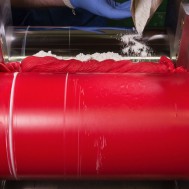Here at Apple Rubber, we take pride in our ever-expanding material offerings. Our lineup is always growing because we often find the need to develop a new material, or to take an existing material and improve upon it. (Please note: we are a custom molder, not a material supplier.) There are a lot of important steps involved in designing a quality seal, but among the most important are the creation and implementation of the right rubber compounds for their eventual seal’s intended purpose. This foundational step helps ensure the future success of our finished rubber products.
The polymer chemists at Apple Rubber have worked on many different rubber compounds throughout their careers. Their creations run the gamut of colors, polymers, and hardness, which is why they’ll be the first to tell you just how many kinds of rubber compounds there are!
Base Polymers
Base polymers are the main determinant of the properties of rubber. Natural rubber compounds, like those used for car tires, are derived from the extract of rubber trees. A rubber compound is created by turning this extract into a base polymer and combining it with fillers, protectants, and curatives. Changing these additives gives the compound its desired physical properties.
Certain base polymers offer better chemical resistance or functional properties, which is why it’s important to know the intended use of your rubber compound. For example, Silicone is used for extreme temperatures, EPDM is used for weather seals, FKM is used for high temperature and chemical resistance, and NBR is used for fuel and oil compatibility.
Although base polymers contain a lot of desired properties on their own, they still need fillers, protectants, and curatives to turn them into functional rubber compounds.
Rubber Activators
Another ingredient in rubber compounds are activators, which are chemicals that aid in vulcanization and help reduce vulcanization time. Rubber activators include sulfur, sulfur donor chemicals, organic peroxides, and metal oxides. The most common rubber activator is sulfur. Sulfur bonds the carbon chains of the polymer and is used at lower operating temperatures. Organic peroxides bond the polymer directly, forming a carbon-to-carbon bond. Usually, these are stronger and can handle higher heat.
Selecting Colors and Fillers
Rubber compounds can be pigmented depending on the filler added to them. These fillers give compounds different hardness and tensile strengths, as well as color.
Carbon black is made from carbon soot and is a common filler used in black rubber compounds. White fillers such as clay or silicon are likewise used for pigmentation. Lubricants can be used to make the surface of the rubber slippery. Waxes can be added to help protect the rubber from ozone, which is a requirement for the aerospace and automotive industries.
There are many other ingredients that can be used to give rubber compounds their different properties. Thanks to their many possible combinations, rubber compounds are unique from one another. Developing them is a science that can take hundreds of hours of testing, adjusting the ratios of ingredients, and compensating for their interactions, in order to perfect a new or improved rubber compound.
Interested in rubber compounds and material offerings?
Connect with one of our engineers here.
